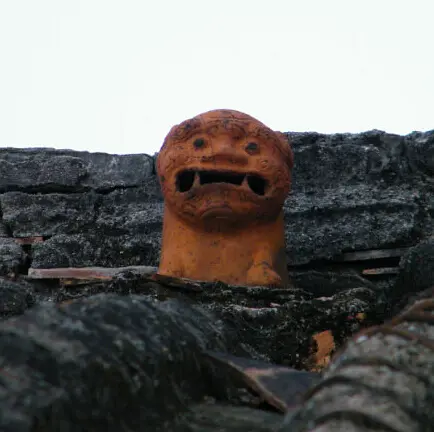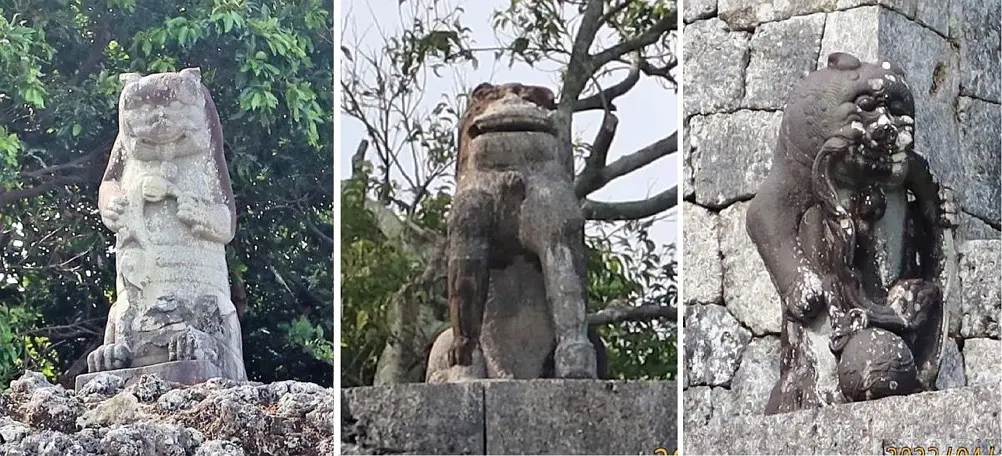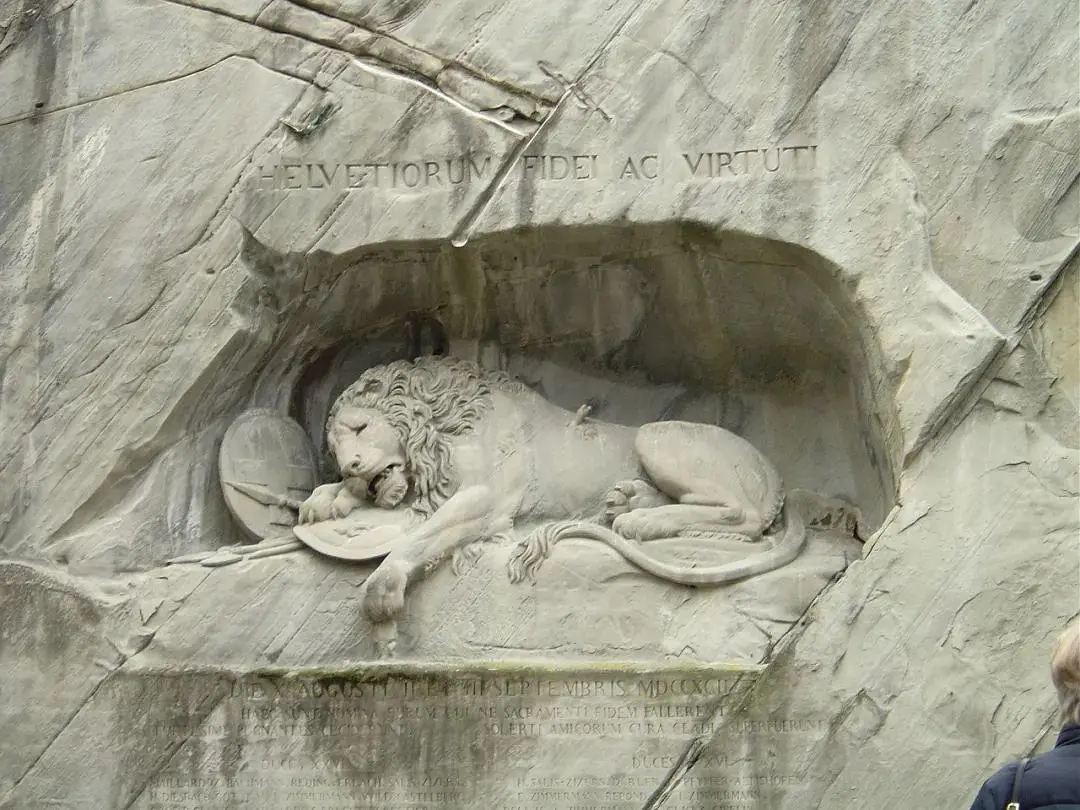Register now to join Ufos Travel and make travel friends around the world
Login to follow friends and send messages. No Account? Register
×
When walking in Okinawa City, you will often encounter stone lions of different styles. In front of the gates of houses, on low walls, in the flower beds outside restaurants, in the windows of shops facing the street, and on the shelves of shops, they grin at passers-by.
When you first look at it, you can’t help but feel a sense of intimacy like meeting an old friend in a foreign land, but if you look closely, you will find that it is much more relaxed and relaxed than the stone beasts in front of domestic agencies. Just like cattle and horses taking off their armor and returning to the fields, the smell of the class is gone, and a look of happiness is revealed unconsciously.

After searching, it is not surprising that the Okinawa stone lions come from China; what is slightly surprising is that although the Chinese and Glazed stone lions can be traced back to a common ancestor , butthis ancestor did not come from the African savannah, but from ancient India. In Indian Buddhism, the lion and god are one, a divine beast that is born with its own organization. "The Buddha Said Prince Rui Ying Ben Qi Sutra" records: When the Buddha was first born, five hundred lions came from the snowy mountains and waited beside the gate.
Manjushri Bodhisattva’s mount is also a green-haired lion. This green-haired lion briefly pretended to be the king of the Black Chicken Kingdom in the lower realm in "Journey to the West", and was later recalled by the Bodhisattva.

As an animal that most Chinese people had never seen at that time, with multiple BUFFs such as mythology, religion, and royal power, The foreign lion finally defeated the local tiger, which had mixed images, and was able to join the immortal class with the dragon and phoenix. It entered the palaces, temples, and mansions of the wealthy. In the early Ming Dynasty, it was introduced to Ryukyu along with the thirty-six surnames of the Fujian people.
In China, stone lions are divided into northern and southern factions. The typical stone lions of northern China are the two that have been on duty in the Hall of Supreme Harmony in the Forbidden City for more than 600 years. They have majestic faces, strong chest muscles, meticulous shawls with big waves, and bells hanging around their necks to ward off evil spirits and ward off evil spirits. It can be called the oldest royal civil servant.

To be spread to the south represented by Fujian and southern Fujian, Shishi has given up his official status, idol burden and Expression management has also been wiped out, and a lot of ordinary people's emotions and emotions are incorporated into their expressions, just like a group of large lion-faced pet dogs.


The stone lion at Kaiyuan Temple in Quanzhou/photo by Chen Yingjie
In the 1400s, China and Ryukyu The country initiated vassal diplomacy, sending a large number of craftsmen from Fujian and southern Fujian to Ryukyu, and also brought the stone lion culture of Fujian to Ryukyu. The first thing to be affected was the tomb culture. During the period of King Shoshin, the first decoration of two lions playing with a ball appeared on the sarcophagus of Urasoe Yodore. Two round-headed lions played with a hydrangea ball with a serious look on their faces.

After that, lion statues appeared one after another on the Zuisen Gate, Xiaohui Gate, and stone bridge railings of Shuri Castle. Their appearance is similar to the fusion of southern and northern lions, and their temperament is between The nobility of the north and the nobility of the south In the city, his figure is more soft and cheerful like a southern lion, and he wears the same curly hair as a distant relative of the Beijing royal family. He looks like a "reasonable provincial civil servant". The material is mainly made of "diabase", a stone commonly used in Fujian and southern Fujian. . During this period, lion images mainly appeared in tombs, palaces, temples, and clan mansions, and were collectively referred to as "palace lions."

Shuri Castle Shisa, Source: shimancyu-koubou

In terms of materials, the commonly used stone "Hui Green" in Fujian and southern Fujian is mainly used "Rock", because Okinawa does not produce diabase locally, it is generally believed that the stone was brought from China.
Two or three hundred years later, the stone lion culture spread from the royal palace of Okinawa to the people. The typical representative of this period is the "Fusheng Stone Lion" in Fusheng, Yaese Town, south of Naha. It was built in the 21st year of King Shosho (1689) and is said to be the oldest existing one. The ancient village lion. This lion faces Mount Yaese and is intended to resist the mountain fire coming from Mount Yaese.

During the Battle of Okinawa, the U.S. military hiding behind stone lions (this lion, which side are you from?)
The appearance follows the shape of a palace lion, but "the shape has become softer." Kuniyoshi Boji, who once worked at Okinawa University of Arts, said:

"It is similar to the early Compared with the lion statues in the royal temples and temple tombs, this stone lion feels tolerant rather than threatening, as if it is not chasing away evil spirits and disasters, but embracing them and making them repent.”
Yes, if the lion returns to the village and pretends to be talking about his former title, he will definitely be disliked by the villagers.
After the completion of the "Fusheng Stone Lion", skilled craftsmen in the villages in southern Okinawa showed their talents and used Ryukyu limestone locally to complete a large number of "Village Lions" in a short period of time. ", Completed the "social" transformation of stone lions. Most of these village lions are built at the entrance of the village. Some are used to avoid fire, some are to suppress hostile villages, and some are to ward off evil spirits.


It is worth mentioning that the neighboring Motobu Village and Zhaowu Village are due to the use of water wells Disputes often arise over rights. In order to resist the wildfires in Yaeze, Motobu Village built a stone lion in the direction of Yaeze. Teruya Village in the same direction as Yaeze thought that Fu Sheng's lion was heading towards them, so they made a pair of stone lion statues and cursed each other in the air. However, as of today, the expressions of these two lions look particularly childish and cute. From their appearance, one cannot believe their fighting power at all. Some Japanese netizens complained, "Will you really lose your fighting spirit after seeing such an expression?"


Although it is the same art form, due to the differences in people's temperament and folk customs, , the results will also be different. After all, just like China, no one in Ryukyu at that time had ever seen a real lion. The image of stone lions generally comes from the imagination of craftsmen and references to the images of people and animals around them. The craftsmen in the village have greatly simplified the shape of the stone lions, generally retaining the eyes, nose, mouth and teeth, and removing decorative elements such as manes, bells, and bases. Some even leave only a big face, full of looseness. And a not too smart smile.

Entrance of Shinjo Village, Yaese-cho - Shinjo Shrine, Source: de-jin studio

Toyomi-Tashiro-the one with only one face Shisa
Contrast this with the "Dying Lion Statue" designed by Danish sculptor Bartel Thorvaldsen. The differences in painting styles clearly transcend race.

The characteristics of the material are also important factors. Ryukyu is rich in limestone, which is a rock formed from coral reefs and surrounding sediments. It is softer and easier to work than other stones, but it also makes craftsmen somewhat "incapable" of achieving fine details.
Today, most of the limestone village lions in southern Okinawa that survived World War II and have been preserved to this day have been eroded by wind and rain, and it is difficult to judge from their appearance what they looked like when they were first built.


After the Meiji Restoration, the Ryukyu Kingdom was changed to the Ryukyu Domain. In 1889 (Meiji 22nd), a series of restrictions on courtyards and houses that had been implemented during the Ryukyu Kingdom were abolished. The once restricted red tiles have appeared on houses all over the country, and lion statues made of plaster and ceramics have also appeared on the roofs of houses. Stucco and clay are more suitable for fine production, and the image of folk stone lions is becoming more and more vivid and lively.


Later, Ryukyu stone lions were integrated with Japan’s native mythical beast “Komon” and other cultures,Finally It has formed iconic elements such as protruding eyeballs, fangs, horns on the head, and sunflower-like mane. It often appears with one mouth open (male) and one closed mouth (female). Among Okinawan folk, the pronunciation of Shishi has also changed from "Shishi", which is the transliteration of the Chinese character Shishi, to the more readable "Shisa".
With the advancement of marketization, Okinawa stone lions have become more diverse. <span style="font-weight: bold;">When walking on the streets of Okinawa, it is very interesting to observe the different styles of stone lions in front of each house. The stone lions have become a symbol of the owner's personality and aesthetics</span style="font-weight: bold;"> span>. What impressed me the most was the two standing Shisa statues wearing traditional Japanese clothes that I saw in front of the houses on Minna Island. The loving owner of the house made more than one set of clothes for the two lions. Seeing such a lion, it is inevitable to think that "this person must be interesting and social".


Civilization always emanates from the center outwards. When palace etiquette reaches the people, it becomes Folklore. Palace culture is a reflection of the interests of the royal class. Its symbolic significance is far greater than its functionality, and it emphasizes inheritance and standardization more than innovation. Among the people, culture is integrated into the thoughts and wishes of ordinary people, simple life and aesthetics. It does not need to stay on the ancient shapes, but will spontaneously integrate into the functional aesthetics of each era to complete the continuation of vitality.

Today, Shisa has been given a new role. From statues suitable for buildings and pet dogs, to hand-sized Tourist souvenirs, to product series for merchants, Shisa has no He is everywhere and has become Okinawa’s mascot and Okinawa IP. So much so that when you see this cute little lion, you will immediately think of Okinawa. In Tokuchi, I even saw a construction sign in the shape of a Shisa.






Today, this stone lion culture originated in India and emerged in China, but it has become an endangered animal in Chinese cities. It is almost hard to imagine that any company or business would choose two large and heavy stone lions to decorate their door lintels when moving into a new home. When bored, it is also fun to pick the stone balls in the lion's mouth with your little hands. Gradually faded out of life.

The lucky few who are still alive have also been forced to transform into food delivery guards. Five or six hundred years ago, after winning the battle with the tiger, this popular official mythical beast was finally defeated in the game between tradition and modernity. Perhaps, at all times and in all countries, disarming and returning to the fields is the potential law for the continuation of the lives of cattle and horses. |
 A travel guide to Tokyo Sensoji Temple--Kaminarimon,Nakamise Street,Five-storied Pagoda
515 Read
A travel guide to Tokyo Sensoji Temple--Kaminarimon,Nakamise Street,Five-storied Pagoda
515 Read
 Sapporo nightlife bar recommendation UTAGE SAPPORO, foreigners and girls free entry
987 Read
Sapporo nightlife bar recommendation UTAGE SAPPORO, foreigners and girls free entry
987 Read
 City Drunk Bar?, a must-visit bar in Osaka, a Chinese bar near Nihonbashi
814 Read
City Drunk Bar?, a must-visit bar in Osaka, a Chinese bar near Nihonbashi
814 Read
 CLUB FOCUS ROPPONGI brothel, having sex with innocent Japanese girls aged 18-20
850 Read
CLUB FOCUS ROPPONGI brothel, having sex with innocent Japanese girls aged 18-20
850 Read
 Android APP
Android APP IOS APP
IOS APP